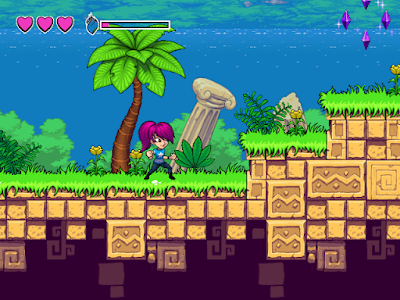When it comes to the Dreamcast indie scene, the name "Senile Team" is surely familiar. You might know them best for bringing us Beats of Rage, the moddable open source beat 'em up engine for Dreamcast (and other systems) that provided the basis for countless community-developed mods of series from Splatterhouse to Resident Evil. Or maybe you've had the pleasure of playing their first commercially released game; the excellent Rush Rush Rally Racing (or its update Rush Rush Rally Reloaded). Either way, it's definitely clear that Senile Team has pedigree when it comes to the Dreamcast, and now they're gearing up for the imminent August 20th release of their latest title, Intrepid Izzy.
The Kickstarter campaign for Intrepid Izzy went up back in 2017 with PC, Dreamcast and PS4 releases promised. The Steam version has been available since July 2020, but it's the Dreamcast version that many people, including us at the Junkyard (obviously) have been eagerly awaiting. Prior to Intrepid Izzy's Dreamcast release, I was supplied a review copy. Staying true to the Junkyard, however, this review will reflect only my honest opinions, with no influence from the developers or distributors.
The game starts with our protagonist Izzy, who is presumed to be a bit of an Indiana Jones explorer-type (she's known to be Intrepid, after all), opening a treasure chest in a temple only to release an evil blue genie whose main priority after finally being released is chaos on the world. From the initial cutscene, you are immediately given a taste of the game's carefree sense of humour, which often leans towards the drier side of things, and can occasionally get a bit bizarre. Just right for us at the Junkyard, then.
So how does Intrepid Izzy play? In the simplest terms, it's a 2D action platformer, with lovely, hand drawn artwork and fluid, cartoon-like animation (created with custom-made animation software) that gives me vibes of the ever-popular Shantae series. But to just call it an "action platformer" wouldn't be doing the game justice, because Intrepid Izzy is actually pretty deep, dude. While the initial stage is a rather left to right affair, you soon realise that the game has a very non-linear approach to its levels. That's right, Intrepid Izzy's core gameplay is what trendy gaming pundits might refer to as "metroidvania." I'm talking levels within levels, with a focus on light puzzle solving and backtracking. Get that key to open that door there, find a helmet to ride the minecart to a new area, find a new costume to grant you the power to get past an obstacle you passed earlier, and so on.
Putting on Intrepid Izzy feels like you're embarking on an adventure, and one that is relatively easy to jump into whether you're a seasoned veteran of this style of explorative platformer, or a complete newbie to it, like I am (unless Kirby & the Amazing Mirror counts). Intrepid Izzy's platforming feels and controls great, and with the constant intrigue of treasure and new areas lurking around every corner, it gets pretty addictive. On countless occasions while exploring, I was conscious that I needed to save and come off so I could continue adding to this review, only to find myself attempting one more puzzle, or leading myself down one more passage.
As you traverse the game's many maze-like levels, you will encounter magic mirrors that grant you quick passage to the game's various other levels, as well as a fast track back to Awesometown, a pleasant town that functions as the game's central hub. You will be returning to Awesometown frequently to recover health by sleeping at Izzy's house and making repeat trips to the town's restaurant to replenish recovery and boosting items (which you purchase with coins that you've picked up throughout your quest). Less frequently, you will be dropping by the house of a bearded wizard, who can upgrade your health at the cost of enough heart fragments, which are hidden sparingly throughout the game's levels. Finally, perhaps taking a page out of Shenmue's book, the last building of significance in Awesometown is an arcade where you can play some basic but fun arcade games - such titles include "Plerg", "Ultra Bazoop" and "3D Wheel".
The other big gameplay element of Intrepid Izzy brings us back to Senile Team's Beats of Rage roots. Implemented alongside the platforming is a beat 'em up combat system that is used to solve environmental puzzles and dispatch enemies. You'll be using these fighting moves throughout your journey to rough up various foes, including huge screen-filling bosses. There are also plenty of occasions during exploration where you will enter a room, only to be locked in, with your only path to escape being to defeat a few waves of enemies. These bouts happen quite frequently, to the point where you soon realise that the combat in Intrepid Izzy is just as important as its platforming.


























































